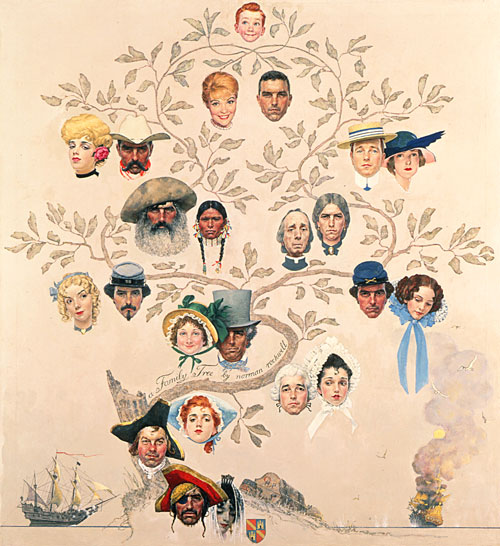

Family Tree, 1959
In 1959, Rockwell began telling his life story to his son Tom Rockwell, who was ghost writing his autobiography, My Adventures as an Illustrator. Recording his family history may have inspired Rockwell to trace the lineage of an American family in a painting, as the final chapter is devoted to a day-by-day account of how Family Tree was created.
The basic structure for the painting, a tree, is taken from a twelfth-century Dutch family tree, a photo of which was found for Rockwell by the reference librarian at the Berkshire Athenaeum. To simulate the appearance of aged parchment, Rockwell stained the background of his painting with brown paint and sketched in trompe l'oeil cracks. For even greater authenticity he rubbed dirt, gravel and twigs into it, shook it off, then rubbed in more. He then sandpapered the surface, which he said gave it a "beautiful texture." The consistency of family features through the generations is assured by Rockwell's use of the same model for either the man or the woman in each couple on the tree.
The lineage begins with a pirate and a Spanish princess, taken by the pirate from a sinking Spanish galleon. The galleon is based on a painting by Rockwell's favorite illustrator of historical subjects, Howard Pyle, whose initials are on the treasure chest.
Rockwell loved the idea of having the "all-American" boy descend from a pirate and his stolen Spanish princess, though it troubled his friend and therapist Erik Erikson. "Do you think you ought to start off the family with him, a cutthroat, a barbarian?" Erikson asked. Rockwell experimented with changing the pirate to a Puritan, then a buccaneer, but finally returned to the original. "Everybody," he said, "had a horse thief or two in his family."
Family Tree, Norman Rockwell, 1959.
Oil on canvas, 46" x 42".
Cover illustration for The Saturday Evening Post, October 24, 1959.
From the permanent collection of Norman Rockwell Museum.